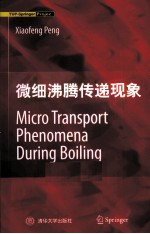

微细沸腾传递现象 英文版PDF电子书下载
- 电子书积分:11 积分如何计算积分?
- 作 者:彭晓峰著
- 出 版 社:北京:清华大学出版社
- 出版年份:2010
- ISBN:9787302223559
- 页数:258 页
1 Introduction 1
1.1 Critical Technology 1
1.2 History and Trends of Boiling 2
1.3 Micro Boiling 3
References 4
2 Thermal Physical Fundamentals 6
2.1 Phase and Phase Equilibrium 6
2.2 Phase Transition 9
2.3 Interfacial Aspects 12
2.4 Contact Angle and Dynamical Contact Behavior 16
2.4.1 Contact Angle at Equilibrium 16
2.4.2 Contact Angle Hysteresis 17
2.4.3 Dynamical Contact Angle 19
2.5 Cluster Dynamics 21
2.5.1 Clusters 21
2.5.2 Number Balance of Activated Molecules in a Cluster 21
2.5.3 Cluster Evolution with Intemal Perturbations 24
2.5.4 Cluster Evolution with External Perturbations 25
References 26
3 Boiling Nucleation 28
3.1 Nucleus Formation 29
3.1.1 Mean Free Path 29
3.1.2 Self-Aggregation 29
3.1.3 Aggregate Formation 31
3.1.4 Critical Aggregation Concentration 33
3.1.5 Infinite Aggregation Formation 34
3.1.6 Physical Configuration of Nucleus Formation 35
3.2 Interfacial Efiects on Nucleation 36
3.2.1 Nucleus Structure Evolution 36
3.2.2 Interfacial Tension of a Nucleus 37
3.2.3 Modification of Nucleation Rate 38
3.3 Microscope Activation neat a F1at Surface 39
3.3.1 Liquid Behavior neat a Heated Wall 39
3.3.2 Nucleation Position 42
3.3.3 Embryo Bubble Evolution 44
3.4 Bubble Evolution from a Cavity 46
3.4.1 Description of Heterogeneous Nucleation 46
3.4.2 Nucleation with One Barrier 50
3.4.3 Heterogeneous Nucleation with Two Barriers 54
References 59
4 Jet Flow Phenomena 60
4.1 Experimental Phenomena 61
4.1.1 Boiling on a Plate Heater 61
4.1.2 Boiling on Small Wires 64
4.2 Bubble-ToP Jet Flow Structure 69
4.2.1 General Features 69
4.2.2 Jet Structure 70
4.2.3 Multi Bubble-Top Jet Flow 71
4.3 Dynamical Behavior of Bubble-Top Jet Flows 72
4.3.1 Jet Flow Evolution 72
4.3.2 Competition and Self-Organization of Jet Flows 75
4.4 Models of Bubble-Top Jet Flow 78
4.4.1 Goveming Equations 78
4.4.2 Fundamental Considerations 79
4.5 Characteristics of Bubble-Top Jet Flow 80
4.5.1 Jet Flow Driving Force and Pumping Effect 80
4.5.2 Jet Flow Bifurcation Phenomenon 82
4.6 Formation of Bubble-Top Jet Flow 85
4.6.1 Temperature Evolution 85
4.6.2 Temperature Evolution on Bubble Interface 88
4.6.3 Flow Evolution 89
References 91
5 Bubble Dynamics on Fine Wires 92
5.1 Modes of Bubble Motion 93
5.1.1 Bubble Sweeping 93
5.1.2 Bubble Interaction 95
5.1.3 Bubble Oscillation Phenomena 97
5.1.4 Bubble Leaping 99
5.2 Fundamentals of Bubble Dynamics 102
5.2.1 Thermocapillary Force 102
5.2.2 Force Caused by Bubble Motion 104
5.2.3 Dynamic Equation 107
5.3 Bubble Sweeping Dynamics 108
5.3.1 Single Bubble Sweeping 108
5.3.2 Bubble Separation from an Immobile Bubble 109
5.3.3 Separation of Two Equivalent Moving Bubbles 113
5.3.4 Separation of Two Non-Equivalent Bubbles 114
5.4 Bubble Collision Dynamics 115
5.4.1 Collision with an Immobile Bubble 115
5.4.2 Collision of Two Equivalent Bubbles 117
5.4.3 Bubble Coalescence 118
5.5 Bubble Oscillation 119
5.5.1 Temperature Profile of a Two Immobile Bubbles System 119
5.5.2 Bubble Oscillation Characteristics 120
5.5.3 Bubble Oscillations with Various Effective Viscosities 122
5.5.4 Coupling Bubble Oscillation 124
5.6 Bubble Leaping Dynamics 126
5.6.1 Dynamical Description 126
5.6.2 Simple Leaping Dynamics 128
5.6.3 Heat Transfer Performance during Bubble Leaping and Sweeping 131
References 131
6 Boiling in Micrchannels 133
6.1 Experimental Observations 134
6.1.1 General Behavior 134
6.1.2 Nucleation Superheat 135
6.1.3 Experimental Phenomena 137
6.2 Physical Explanation 138
6.2.1 Evaporating Space and Fictitious Boiling 138
6.2.2 Thermodynamic Evidence 139
6.2.3 Cluster Dynamical Evidence 141
6.3 Nucleation Criterion 143
6.3.1 Thermodynamic Analysis 143
6.3.2 Statistical Mechanics Approach 145
6.3.3 Dynamic Model 149
6.4 Nucleation Kinetics 151
6.4.1 Bubble Evolution Dynamics near Critical Radius 151
6.4.2 Nucleation in Confined Space 154
6.5 Bubble Dynamic Behavior with Local Heating 158
6.5.1 Experiments 158
6.5.2 Phase Change Behavior 159
6.6 Interface Oscillation 160
6.6.1 Periodic Feature 160
6.6.2 Evaporating Interface 163
6.6.3 Condensing Interface 167
Reterences 172
7 Boiling in Droplets 175
7.1 Oscillation of Sessile Droplets 176
7.1.1 Experimental Observations 176
7.1.2 Oscillatory Behavior 179
7.1.3 Physical Understanding 181
7.2 Model of Droplet Oscillation 184
7.2.1 Physical Model 184
7.2.2 Flow Characteristics 184
7.3 Transitional Boiling Behavior 188
7.3.1 Experimental Description 188
7.3.2 Restricted Cyclical Phase Change 190
7.3.3 Single-Bubble Cyclical Phase Change 191
7.3.4 Metastable Cyclical Phase Change 193
7.4 Droplet Spreading During Evaporation and Nucleation 194
7.4.1 Phenomenon Observations 194
7.4.2 Influencial Factors 195
7.4.3 Spread Area and Spread Speed 197
7.4.4 Heat Fluxes 199
References 200
8 Boiling in Micro-Structures and Porous Media 201
8.1 Experimental Observations 202
8.1.1 Test Apparatus 202
8.1.2 Low Applied Heat Flux 203
8.1.3 Moderate Applied Heat Flux 207
8.1.4 High Applied Heat Flux 207
8.2 Bubble Behavior in Bead-Packed Structure 208
8.2.1 Boiling Process 208
8.2.2 Static Description of Primary Bubble Interface 210
8.2.3 Comparison of Results 212
8.3 Replenishment and Dynamic Behavior of Interface 214
8.3.1 Replenishing Liquid Flow 214
8.3.2 Dynamic Behavior of Bubble Intefface 216
8.3.3 Interfacial Heat and Mass Transfer at Pore-Level 219
8.4 Pore-Scale Bubble Dynamics 222
8.4.1 Introduction 222
8.4.2 Discrete Rising Bubble 223
8.4.3 Bubble Departure Interference 225
8.5 Occurrence of Dryout 226
8.5.1 Lateral Bubble Coalescence and Local Vapor Patch Formation 226
8.5.2 Dryout 227
8.5.3 Discussion and Comparison 228
Reterences 231
9 Explosive Boiling 233
9.1 Experimental Phenomena 234
9.1.1 Visual Observation Test 234
9.1.2 Jet Flow in/from Mini Tubes 236
9.1.3 Exploding Emission from Micro Tubes 239
9.2 Temperature Behavior During Emitting 241
9.3 Theoretical Discussion 244
9.3.1 Geometrical Parameters 244
9.3.2 Critical Emitting Heat Flux 244
9.3.3 Asymmetrical Effect 247
References 249
Index 250
Postscript 254
- 《卓有成效的管理者 中英文双语版》(美)彼得·德鲁克许是祥译;那国毅审校 2019
- 《化工传递过程导论 第2版》阎建民,刘辉 2020
- 《AutoCAD 2018自学视频教程 标准版 中文版》CAD/CAM/CAE技术联盟 2019
- 《跟孩子一起看图学英文》张紫颖著 2019
- 《AutoCAD机械设计实例精解 2019中文版》北京兆迪科技有限公司编著 2019
- 《复分析 英文版》(中国)李娜,马立新 2019
- 《张世祥小提琴启蒙教程 中英文双语版》张世祥编著 2017
- 《生物化学 本科临床 英文版》张晓伟 2018
- 《理想国 全英文原版》(古希腊)柏拉图著 2017
- 《Dreamweaver CC 2018标准实例教程 中文版》杨雪静,胡仁喜编著 2019
- 《大学计算机实验指导及习题解答》曹成志,宋长龙 2019
- 《指向核心素养 北京十一学校名师教学设计 英语 七年级 上 配人教版》周志英总主编 2019
- 《大学生心理健康与人生发展》王琳责任编辑;(中国)肖宇 2019
- 《大学英语四级考试全真试题 标准模拟 四级》汪开虎主编 2012
- 《大学英语教学的跨文化交际视角研究与创新发展》许丽云,刘枫,尚利明著 2020
- 《北京生态环境保护》《北京环境保护丛书》编委会编著 2018
- 《复旦大学新闻学院教授学术丛书 新闻实务随想录》刘海贵 2019
- 《大学英语综合教程 1》王佃春,骆敏主编 2015
- 《大学物理简明教程 下 第2版》施卫主编 2020
- 《指向核心素养 北京十一学校名师教学设计 英语 九年级 上 配人教版》周志英总主编 2019
